Medicine Buddha Mantra lyrics in Sanskrit long version:
Om Namo bhagawate Bhaishjaya Guru
Vaidurya Prabha Rajaya Tathagataya
Arhate Samyaksam Buddhaya Teyatha
Om Bekhajye Bekhajye Maha Bekhajye
Bekhajye Rajaya Samudgate Svaha
Mantra short version:
Tayata
Om Bekandze Bekandze
Maha Bekandze
Radza Samundgate Soha
Medicine Buddha Mantra translation in English:
May the many sentient beings who are sick,
Quickly be freed from sickness.
And may all the sicknesses of beings
Never arise again.
Mantra Tibetan pronunciation:
Tad-ya-ta Om Be-kan-dze Be-kan-dze Ma-ha Be-kan-dze Ra-dza Sa-mung-ga-te So-ha.
Bhaisajyaguru (also known as The First Doctor) is the Buddha of healing and medicine in Mahayana Buddhism tradition, aka the ”Medicine Buddha.”
The original name of this healing mantra is Bhaisajyaguru Vaidurya Prabharaja. Bhaisajyaguruvaiḍuryaprabharaja Sutra (Medicine Buddha mantra Tibetan script) was found in Gilgit, Pakistan, and Afghanistan, dated before the 7th century.
On achieving Buddha-hood, Bhaisajyaguru became the Buddha of the eastern pure land of Vaiḍuryanirbhasa, “Pure Lapis Lazuli.” There, Bhaisajyaguru is attended to by two Bodhisattvas symbolizing the light of the sun (Suryaprabha) and the light of the moon (Candraprabha).
The practice of veneration and adoration of Bhaisajyaguru is also popular in China, as Bhaisajyaguru is described as one of the trinity of Buddhas, the others being Gautama Buddha and Buddha Amitabha.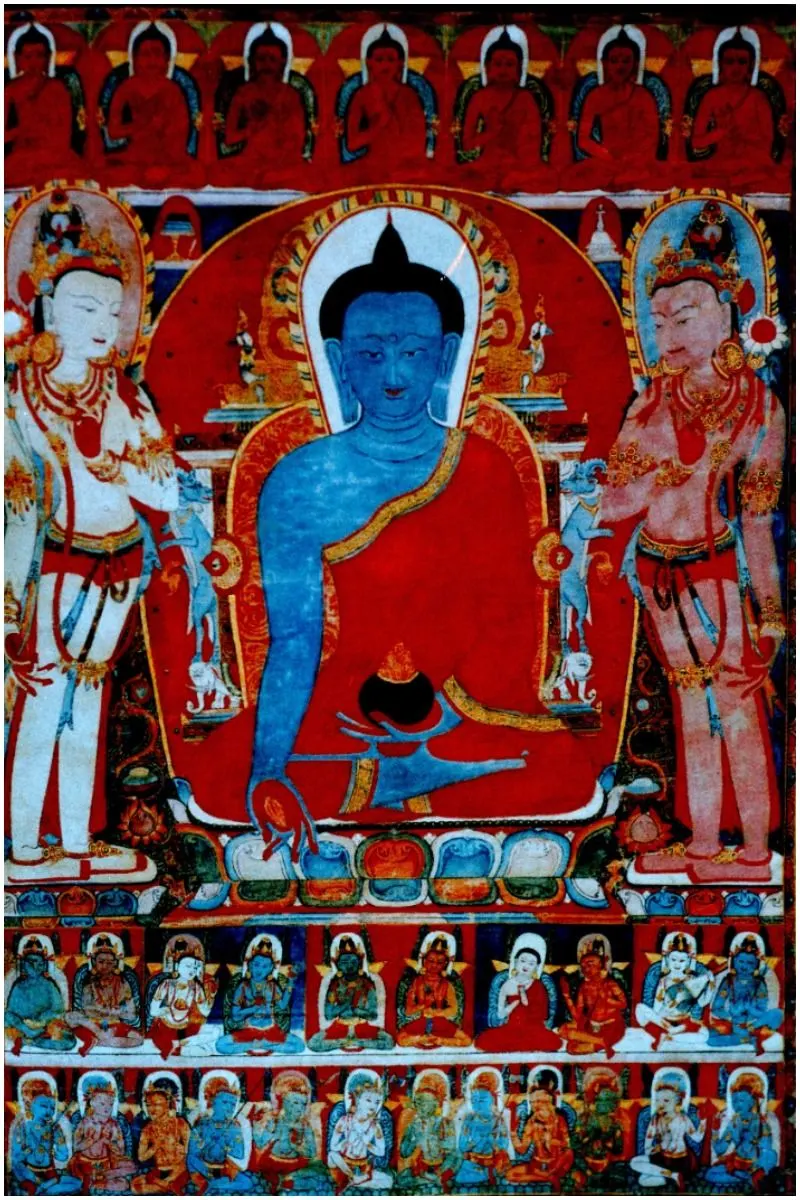
According to this Sutra, Bhaisajyaguru took twelve vows:
- To illuminate countless realms with his radiance, enabling anyone to become a Buddha just like him.
- To provide the sentient beings with whatever material needs they require.
- To awaken the minds of sentient beings through his light of lapis lazuli.
- To correct heretical views and inspire beings toward the path of the Bodhisattva.
- To heal beings born with deformities, illness, or other physical sufferings.
- To help beings follow Moral Precepts, even if they failed before.
- To help relieve the destitute and the sick.
- To help heal mental afflictions and delusions.
- To help women who wish to be reborn as men achieve their desired rebirth.
- To help the oppressed be free from suffering.
- To relieve those who suffer from terrible hunger and thirst.
- To help clothe those who are destitute and suffering from cold and mosquitoes.
According to Bhaisajyaguruvaiduryaprabharaja Sutra (Bhaisajyaguru Sutra), the long version is considered a dharani (a type of long mantra) and was first spoken by Medicine Buddha when he was in samadhi (a deep meditation state).
Medicine Buddha’s function is to release living beings from mental, emotional, and physical sickness by bestowing blessings on them.
His body of blue wisdom light represents that Bhaisajyaguru is an emanation of the healing power of all enlightened beings.
Iconography
Bhaisajyaguru is usually depicted seated, wearing the 3 robes of a Buddhist monk, the right hand resting on his right knee, and holding a lapis-colored (lapis is an intensely deep blue stone that usually contains gold-colored flecks of pyrite) jar of medicine nectar in his left hand, holding the stem of the Aruna fruit (in Tibetan images, a myrobalan plant.
In Tibetan medicine, this plant – myrobalan is believed to be the universal treatment, which may cure all 404 diseases, known in the Tibetan clinical medicine) between forefinger and thumb.
Moreover, He is frequently described in Tibetan Buddhism as azure blue, or more commonly known as Lapis Lazuli. In Chinese illustrations, Bhaisajyaguru is occasionally illustrated holding a pagoda, symbolizing the ten thousand Buddhas of the 3 periods of time.
Benefits Of Chanting Medicine Buddha Mantra:
Practicing this mantra, it cures us of physical disease, if we chant it 108 times near a glass of water (and with correct pronunciation), the water will be blessed with the healing powers of the mantra.
If we recite this mantra every day (minimum of five malas, 1 mala = 108 repetitions), the mantra will purify our negative karma. Also, the daily chanting of the mantra can help the practitioner to overcome physical, mental and spiritual sickness.
Advice from Lama Zopa Rinpoche:
“If you can recite Bhaisajyaguru mantra as much as you can every day (good to do at least 5 malas), this will purify negative karma and will help you never to be reborn in the lower realms.”
Lama Zopa Rinpoche also stated – ”Besides the benefits you receive from reciting this medicine mantra, also these are the benefits just from hearing the mantra. Thus, this mantra is much more precious than the whole sky full of diamonds and infinite jewels. With this healing mantra, you can liberate numberless sentient beings from oceans of suffering and bring them to enlightenment.
Therefore, again, reciting even one mantra or hearing just once this mantra is much more precious than the sky filled with diamonds, gold, wish-fulfilling jewels and zillions and zillions of dollars.”
READ MORE: Green Tara Mantra
Practice
We can practice this healing mantra for the benefit of others and in the end, we consecrate the mantra’s merits (for the person we think about).
Moreover, when we practice this sadhana with a sincere heart, we receive a special power of body, speech, and mind, which we can use to help others through healing actions. Medicine Buddha statue or The Healing Buddha statue is also used in Feng Shui for healing.
Lama Tashi Namgyal explained:
“It is very important to consciously dedicate the awareness, energy, and blessings you have received from the practice to the benefit of all sentient life. You remember it is limitless and allow it to flow endlessly out into all corners of the universe.
When you finish this powerful practice, you arise and enter your daily life conscious of the transcendental energy generated by the non-dual view.
If you are working on your own healing, the healing of another, or if you are a healthcare practitioner, staying close to the view serves to continue the Medicine Buddha healing. For however long it lasts, you try and stay close to this as you re-engage behavior, speech, and thoughts, through the Buddha body, Buddha speech, and Buddha mind.”
There is no special permission (lung in Tibetan) or transmission required in order to practice the mantra of the Medicine Buddha and receive the healing benefits of the practice.
If you find the mantra practice helpful and inspiring and want to access the more profound levels of meaning and healing it is recommended that you seek a “Lung” or transmission of the Medicine Buddha from a Tibetan lama; that in turn requires a commitment and dedication to the practice over time, whereby you and all sentient beings will be able to accumulate benefit from the healing energy of the Medicine Buddha.
“If one meditates on the Medicine Buddha, one will eventually attain enlightenment, but in the meantime, one will experience an increase in healing powers both for oneself and others and a decrease in physical, emotional, and mental illness and suffering.”
More importantly, numerous Tibetan Buddhists include a Medicine Buddha practice in their daily meditation, even these days. Those who are not able to do that try to practice the Sadhana of the Medicine Buddha on auspicious days – especially on the first quarter moon day, which is known as the Medicine Buddha Day.
This is the waxing half-moon day, the 8th day of the lunar month, counting the new moon as the first day. Furthermore, Tibetan doctors do the Medicine Buddha practice while they are making herbal medicines, and while they are working with their patients.
Read on insightstate about more soothing mantras, like Om Mani Padme Hum, 100 Syllable Mantra, Moola Mantra, or Great Compassion Mantra.
Images credit – Shutterstock & Getty Images
References https://buddhaweekly.com/the-first-doctor-medicine-buddha-bhaisajyaguru/ https://www.shambhala.com/snowlion_articles/medicine-buddha-teachings/
- About the Author
- Latest Posts
As a founder and chief author at InsightState.com, Bulgarea Candin helps readers on their spiritual journeys. His writings are designed to inspire creativity and personal growth, guiding readers on their journey to a more fulfilled and enlightened life.

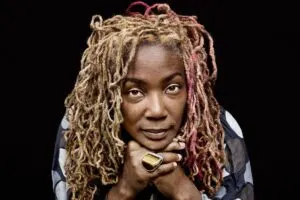
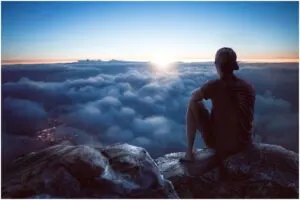
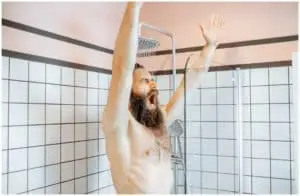
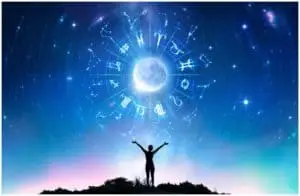
Maria Inês Paschoarelli Veiga
Wednesday 17th of August 2016
Well, I do consider compassion the supreme virtue, but I read the vows of the Medicine Buddha in his Sutra and I am shocked with the vow about women wanting to reborn as a man. Why not grant the wish to men who want to reborn as a woman, The vows are all about promisses of better situations and liberation of bad ones. In the context, I can not avoid the idea that the Medicine Buddha considers being a woman something that is inferior, that one is better off as a man than as a woman. I am a woman and I could not avoid the shock and the hurt when I read the Eighth Vow when is said "...women who are extremely disgusted with the hundred afflictions that befall women and wish to abandon the female form...". As I said before, the Buddha promises illumination (in oposition to ignorance and such ), awakening of minds that are dwelling in the darkeness, set those in heretical ways in the path of Enlightment and so on. In a nutshell, being a woman is a situation similar to diseases, sin and ignorance. I am not here to judge, to condemn or criticize, I am here searching undertanding, but I can not deny my own eyes, it all is written very clear in the Sutra. So, if someone can help me in this I will be deeply grateful, because I am so very tired of religions placing women as inferior to men. It really hurts very much when one are searching with all her heart for God and every and each time, religions treat us, women, as second class people.
M
Sunday 4th of June 2023
@Maria Inês Paschoarelli Veiga, If a man strongly wished to be reborn as a woman, that also would be granted. You are misunderstanding and applying your own preconceived perceptions and ideas.
M
Sunday 4th of June 2023
@Kristine Buckley, being a woman is wrought with many difficulties. You are simply misunderstanding. It is from compassion.
Kristine Buckley
Wednesday 1st of December 2021
@Insight State, Like the commenter before me, I too feel stabbed in the heart by the 9th vow. How can Bhaisajyaguru be a Buddha, have attained enlightenment, as a misogynist? Misogyny exists as a construct of ego - the prejudice against women for a man to feel superior. Clearly Bhaisajyaguru could not transcend his ego and therefore could not be enlightened. Suppose Vow #9 read, "To help black people who wish to be reborn as white people achieve their desired rebirth." Would he be considered a Buddha? What other Buddhist teachings have been contaminated with the male ego? THe fact that Vow 9 is in print in almost the year 2022, shows me that Buddhism has some very very very serious problems. ANY misogyny that exists within the Buddhist community needs to be addressed immediately. How can enlightenment be attained when one holds onto prejudice constructed by the ego out of primal fear? Sorry. After reading this passage Buddhism blew up for me. Years of learning have been shredded. The only thing that exists is the Nad, the sound current, and therefore the mantras. All the other stuff cannot be trusted. What else has the male ego invented? Shame on the leadership of the Buddhist community!
Insight State
Wednesday 17th of August 2016
Shakyamuni Buddha permitted women to join his monastic community and fully participate in it (the first Buddhist nun is said to be Prajapati). But, there are also examples in the Theravada Sutta Pitaka that suggest that the very concept of gender differentiation can serve as a hindrance to attaining enlightenment, or nirvana. This is not a consistent view, as the Buddha's stepmother was said to have become an arhat.
In a sutta titled "Bondage", the Buddha states that when ”either a man or a woman clings to gender identity, that person is in bondage”. Being a man or a woman is only part of what makes us a human being. However to believe that because one is a woman one is spiritually inferior is a trap set up by ancient patriarchal mores, still unfortunately partially existing today.
”Here there is no man, there is no woman, No self, no person, and no consciousness. The labels ‘male’ or ‘female’ have no essence, But deceive the evil-minded world.” - Jnanachandra